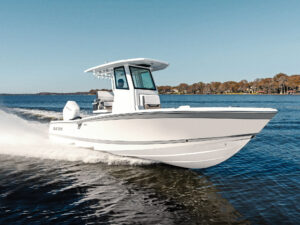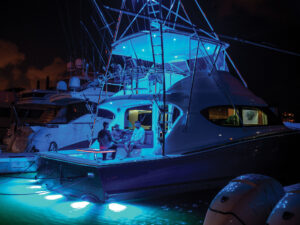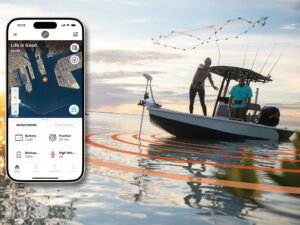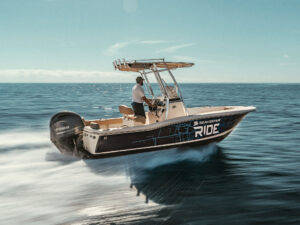Bigger is better. At least that’s the premise for Seven Marine’s entry into the highly competitive outboard power market. The Wisconsin-based company created quite a buzz at this year’s Miami International Boat Show with the launch of its 557 model. The supercharged V-8 packs 557 horses into its massive frame and tips the scales at 1,000 pounds. It competes with Yamaha’s F350 V-8, Mercury’s Verado Pro 300 and Suzuki’s DF300 in the four-stroke class and Evinrude’s 300 E-TEC direct-injection two-stroke. It also offers another choice for boaters considering inboard pod power from Volvo or Cummins MerCruiser Diesel.
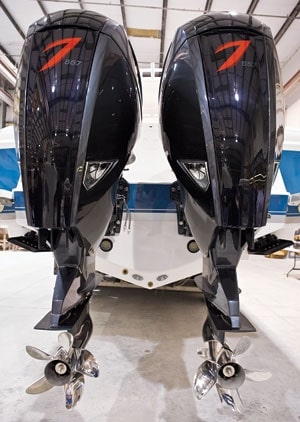
Trend Up
“We started seeing the big center console offshore and go-fast boats with triples and quad outboards,” says Brian Davis, vice president of Seven Marine. “We also saw the lunatic fringe with five outboards strapped to the back and realized the market is clearly asking for more power. With a pair of our 557s, you’ll be decreasing the drag, decreasing overall weight and increasing power over triples. The efficiency will be better too. Our projections show a fuel rate of 11.6 gallons per hour per engine with a boat cruising at 3,200 to 3,400 rpm at 45 miles per hour. We also anticipate a top speed into the mid-70s with a 37-foot boat. This proven block and unique engineering will be able to deliver all that power to the water.”
The 557 is based on General Motors’ Cadillac CTS-V aluminum block engine. This compact power plant has millions of dollars of research and development behind it and a proven marine track record in sterndrive and inboard applications. The 557 outboard block is mounted horizontally and uses a ZF transmission in the midsection for shifting. Seven Marine designed the twin-pinion gear case to transfer the energy into the water. But that’s not the only engineering collaboration tied to this project.
All-Star Team
Alfa Laval, a leader in high-flow cooling systems, designed the 557’s coolers, located under the cowling. The closed-loop system doesn’t use salt water. Seven Marine engineered the hydraulic power steering and trim, which is produced by Latham Marine. Custom Marine developed the dual-wall stainless-steel tubular header exhaust. Other partners include Herring, with high-performance propellers, and DuPont, with corrosion-resistant coatings. The Seven Marine team is led by industry veteran Rick Davis. Davis is the former chief technology officer and vice president of engine development at Mercury Marine. His son Eric came up with the concept for the 557. The Davis family has always been fanatical about racing, and seven was Eric’s race number, hence the company name.
The 557 is compatible with the ZF SmartCommand control system and comes with a helm joystick for effortless shifting and easy docking capabilities in combination with a bow thruster. “This is the first application of big-boat controls in an outboard configuration,” Rick Davis explains. Seven Marine will also offer custom engine colors. “Our color is whatever the customer wants,” he says.
Plays Well
For the official launch in Miami, Intrepid Powerboats was the showcased builder, but the 557 will be available to other builders too. It’ll also be sold factory-direct to individuals looking to re-power.
“It’s a good matchup for our company, especially on our new 475 and 54 that we have on the drawing board,” says Mark Beaver, chief operating officer for Intrepid. “We’ll mount as many on our boats as other companies. The 557 will be for owners who want to make a statement. They can take their boats offshore and really wring ’em out.”
Anglers Option
But will these monster engines help you catch more fish? Seven Marine’s official fish-head, vice president Sandy Ballou, believes they will. “Without modification, the engines would be too fast in idle forward for trolling,” Ballou explains. “But with the ZF transmission, we’re able to dial the revolutions per minute down to any setting you want, thanks to the wet slip control. So you’ll have the same advantage as the big sport-fishers do with trolling valves.
“You’ll also be able to run fast and cover long distances efficiently,” he says. “So you can get to the fishing grounds first and be the last to leave. That will allow you to maximize your time on the water. Plus, while you’re fishing, you’ll have precision control for the ideal bait presentation. It’s a great combo.”
Based on those last features alone, the 557s should be a big hit, despite the hefty price tag of $68,900 each. Testing on the new engines will con-tinue for the next few months; production models should be available by the fourth quarter of this year.
So is bigger really better? The jury is still out. But the trend is certainly shifting that way.
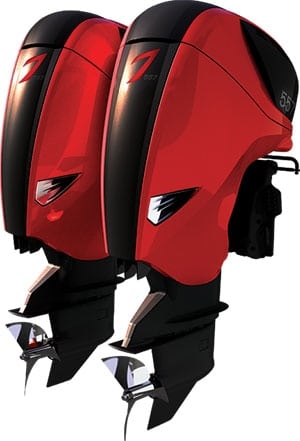
Rated power: 557 hp
Displacement: 6,162 cc
Alternator: 12V 150A
Weight: 1,000 lbs.
Price: $68,900
Induction system: 1.9L TVS supercharged and intercooled
Cooling system: Closed loop
Fuel system: Returnless center feed with multipoint injection with stainless-steel fuel rail
Steering: Integrated hydraulic power
Exhaust: Stainless manifolds with dual overboard exhaust
Gear shift: Electronically controlled wet clutch
Shaft lengths: 20/25/30 inches
Rotation: Clockwise and counterclockwise
Fuel: 89-octane compatible; 92 octane recommended Seven Marine:
877-777-0330
www.seven-marine.com Courtesy

